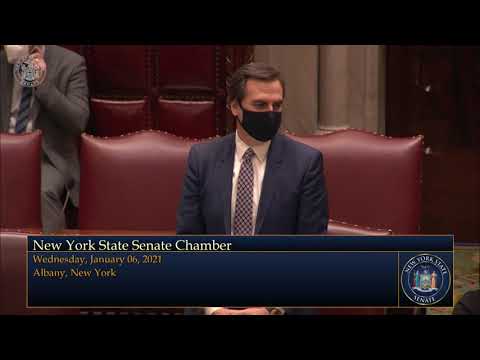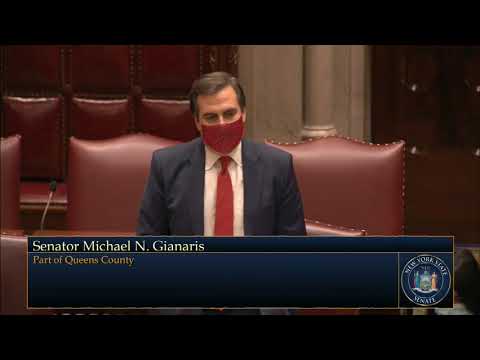
Washington Post: New York’s redistricting tests Democratic opposition to gerrymandering

Reconfiguring New York’s congressional districts to benefit Democrats represents perhaps the party’s best shot at keeping the House majority. To do so, state Democrats will need to wrestle control of the redistricting process away from a bipartisan commission set up by voters after the last redrawing.
The temptation to do so will be great: This year marks the first time in a century that the New York Democrats have total control of state government, giving them autonomy over redistricting if they choose to take it.
Republicans trail Democrats by only eight seats in the U.S. House of Representatives, so the GOP flipping a handful of seats in the midterms would ensure President Biden achieves nothing on his legislative policy agenda in the last two years of his term. Republicans are expected to gain through population growth — particularly in the Sun Belt — that has given some red states additional seats, and through redistricting in places they control. That has put a heavy burden on one of the nation’s most Democratic states.
“It’s almost political malpractice not to in this hyperpartisan environment in the United States right now, but it doesn’t mean it’s right,” said Blair Horner, executive director of New York Public Interest Research Group, which opposes partisan gerrymandering. “There will be enormous pressure from national Democrats to come up with lines that are most favorable, given the opposite is happening in the red states, like Texas. In this crazy system, partisan consideration often rules.”
The state’s new Democratic governor Kathy Hochul, who took over after the resignation of Andrew M. Cuomo, has signaled that she is prepared to leverage her position to help Democrats maximize the party’s gains in a way critics of her predecessor say he never did.
“Yes, I am also the leader of the New York State Democratic Party. I embrace that,” Hochul told the New York Times in August, when asked whether she would use redistricting to help the Democrats hold the U.S. House. The governor’s office did not respond to a request for comment.
Eric Holder, who was attorney general in the Obama administration and now heads an organization that has sued to prevent gerrymandering, argued that Democrats in New York won’t need to gerrymander to pick up seats.
“I am against partisan and racial gerrymandering and by saying that I don’t think I’m being weak to the interests of my party. I think Democrats, progressives will do just fine if the system is fair, we’ll have the advantage we deserve,” he told reporters on a call Friday. “If you look at New York, if you look at the population shifts in New York, New York is even more urban than it was, there are much fewer rural votes, you would expect a decrease of Republican seats. That’s not a function of gerrymandering, that is a function of the number of people there, their partisan proclivities, as opposed to what you are going to see in Ohio, Texas, Georgia, regardless of what voters want.”
During the last redistricting in 2011, Democrats held the state Assembly, but Republicans had the majority in the state Senate. They failed to agree on a congressional map, and a federal court was forced to step in and draw the lines.
“New York has been willing to let even the last minute pass and to abdicate the whole of its redistricting power to a reluctant federal court,” the judges wrote at the time.
The greatest casualty, as it turns out, was Hochul, then a first-term congresswoman, who lost her bid for reelection in 2012 because the court-drawn map shifted her already competitive district into more conservative territory near the Canadian border.
For that year’s legislative maps, Cuomo cut a deal with Republicans, and signed the GOP-majority state Senate’s gerrymandered map, in exchange for their support for a ballot referendum to end future partisan gerrymandering.
In 2014, voters approved a constitutional amendment to set up a separate entity outside the state legislature to control redistricting. The 10-member commission is split equally along partisan lines. Of them, eight were appointed by partisan legislative leaders, which critics point to as evidence that it was set up to fail and ultimately give the legislature final say over the maps.
“It was a hallmark of the Cuomo administration to introduce bold measures to make great headlines that have little to no substance. The redistricting deal is that kind of deal,” said Susan Lerner, executive director of Common Cause New York, which did not support the referendum, declaring it inadequate. “Clearly the desperate desire for a deal overcame good governance.”
So far, critics like Lerner have been right. In its first attempt this year to draw new maps, the commission couldn’t agree, with Democrats drafting one map and Republicans another. If the two sides remain at an impasse, redrawing the lines will fall to the legislators who voters wanted out of the process. Even if the commission does ultimately agree on a map, the state lawmakers are allowed to reject it and draw their own.
State Sen. Michael Gianaris (D), chairman of the legislature’s redistricting committee, which will draw the maps if the advisory commission fails to do so, also blamed Cuomo. He said the former governor — who resigned after the state attorney general found that he sexually harassed several women — was more interested in his own political fortunes than helping out other Democrats.
“Everyone is now seeing how awful Andrew Cuomo was, but one of his political manipulations was he supported Republicans in the state and that includes agreeing to their redistricting demands,” he said.
Cuomo spokesman Rich Azzopardi defended the referendum as “the first reforms to the process in decades,” adding that it was “factually inaccurate” to say it was a deal with Republicans because it had the support of some Democrats too.
Lawmakers on the committee charged with drawing the maps if the commission fails to do so have already reached out to members of the New York congressional delegation to seek their input, said one senior Democratic official close to the process. The official, who spoke on the condition of anonymity to discuss internal conversations, said those conversations haven’t started, but they expect national Democrats will push for more Democratic seats.
“I think it’s pretty likely they draw a Democratic gerrymander,” said Adam Podowitz-Thomas of the Princeton Gerrymandering Project, a nonpartisan group that analyzes gerrymandering. “There’s not a huge political cost — when it comes to the ballot box no one picks a politician based on whether they gerrymandered or not.”
National Democrats refused to comment on whether they would endorse gerrymandering in New York as a way to preserve their fragile majority. A spokesman for House Speaker Nancy Pelosi (D-Calif.) did not respond to an inquiry about her role in redistricting. One of her deputies, Rep. Hakeem Jeffries (D-N.Y.) — who as a New York assemblyman introduced legislation banning gerrymandering — declined an interview.
“Nancy Pelosi understands the raw political calculations,” said David Wasserman, a veteran analyst of congressional redistricting for the Cook Political Report. “She understands the GOP is going to be aggressive and she is the farthest type of person who would unilaterally disarm.”
Few have a bigger stake in the new maps than Rep. Sean Maloney, a New York Democrat whose job as chairman of the Democratic Congressional Campaign Committee is to ensure the Democrats keep the House. He also has a personal stake: Maloney would benefit from his mid-Hudson Valley district absorbing more Democratic voters. Although he has won reelection since 2014, the makeup of his district is competitive and redrawing the lines could make life easier for him.
Maloney also declined an interview request, but he said in an emailed statement that Democrats won’t need to gerrymander to win in 2022 if lines are drawn fairly. In 2020, Democrats lost more than a dozen House seats, although their candidates won millions more votes nationwide.
“Remember Democrats won 4.7 million more votes than Republicans in 2020 House races on already-gerrymandered lines,” he said. “It’s no wonder they’re turning to Jim Crow-era tricks to suppress the vote and gerrymander districts. … But here’s our bet: all this deck stacking they’re counting on isn’t going to get them all the way there. With fair lines, we’re going to win on substance.”
Redistricting occurs every 10 years after the Census Bureau releases data on the country’s population changes. New York grew over the last decade, but not at the pace of other states. It lost a congressional seat as faster-growing states with GOP state governments, like Texas, Florida and North Carolina, all gained seats. (North Carolina has a Democratic governor, but he does not have veto power over the GOP-drawn maps.)
New York’s growth occurred in and around heavily Democratic New York City, as more Republicans areas upstate shed population. Based on that, Democrats argue that Republicans should suffer the casualty of the delegation downsizing by losing one of their upstate seats.
Democratic members on the redistricting advisory commission drew a preliminary map that removed the 23rd District held by retiring Republican Rep. Tom Reed, but the rest of the map only made slight tweaks to help Democrats.
The map would make Republican Rep. John Katko’s Democratic-leaning district more solidly Democratic and create opportunities for Democratic pickups by shifting retiring Republican Rep. Lee Zeldin’s Long Island district into a slightly more Democratic territory, according a Washington Post analysis using precinct results from the 2020 presidential election. Shocking to outside Democrats is that the plan could move the party’s freshmen Reps. Mondaire Jones and Jamaal Bowman into the same district.
Overall, the map does not guarantee Democrats more seats in Congress. The current makeup of the delegation is 19 Democrats and eight Republicans. The new map would have 18 Democratic-leaning districts, four swing districts and four GOP-leaning districts, according to The Post’s analysis.
The Republican commission map, by contrast, eliminates two Democratic-leaning districts and creates an additional Republican one.
David Imamura and Jack Martins, the Democratic and Republican-appointed chairmen of the commission, respectively, said in separate interviews that they did not consider where incumbents live or the political affiliations of voters in drawing the lines.
Imamura said he hasn’t give up hope that “everyone can still come together on a single bipartisan map. That’s certainly our goal to achieve that mandate.”
Martins, a former GOP state senator, also said he remained hopeful the commission could “work through all the noise, whether that’s coming from Washington or from Albany, and put these maps together.” He and other Republican-appointed commissioners had lamented at the Sept. 15 public hearing, where they released the draft maps, that the commission didn’t try to reach a consensus.
“I’ve gone from being very hopeful to being supremely disappointed, but I’m keeping my hope that there is room for atonement,” said Ross Brady, another commission member who aligns with the Republicans.
Republicans are readying for a legal fight, presuming the maps will be drawn exclusively by the Democrats.
“Democrats have no interest in negotiating in good faith as evidenced by their Party’s leader Kathy Hochul’s comments she intends to gerrymander Democrats into power,” Nick Langworthy, the GOP state chairman, said in a written statement. “They are going to stonewall and drag this process out hoping New Yorkers aren’t paying attention so partisan legislators can draw their own maps. We intend to employ every legal and political tool in our arsenal to stop them and ensure New Yorkers are fairly represented.”
National Republicans are also crying foul over the specter of New York gerrymandering.
“They want the commission to fail so they have the opportunity to gerrymander the state,” said Adam Kincaid, executive director of the National Republican Redistricting Trust, which supports GOP interests in redistricting.
Democrats argue that they are simply moving to “fair lines” — a common term among anti-gerrymandering advocates — to better reflect underrepresented communities, which has the collateral effect of helping their candidates because those constituencies tend to vote for Democrats. Many point to Long Island, which has four congressional districts, none of which are majority-minority despite growing populations of Black and Latino residents there.
“My view has been that given what we’ve lived under, simply moving to fair lines will benefit the Democrats,” Gianaris said.
Kelly Ward, president of Holder’s group, the National Democratic Redistricting Committee, also contended that Democrats won’t need to gerrymander to pick up seats in New York and elsewhere.
“In Democratic states, if those maps are drawn fairly, Democrats should pick up seats because population growth … is happening because of growth in minority communities that are less rural and more diverse,” she said. “We don’t have to cheat and push the envelope, Republicans are swimming upstream against the data.”
Whether New York Democrats can withstand the temptation to gerrymander beyond that to aid their party’s House chances and blunt expected gerrymanders by Republicans elsewhere remains to be seen.
“At the end of the day, you can create all the standards in the world,” Horner said. “You need experts who don’t have an ax to grind.”



